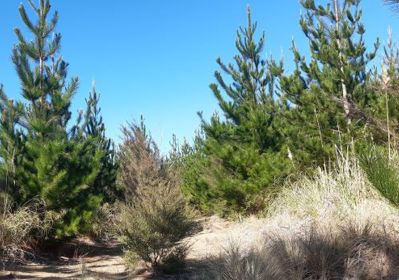Wilding conifer programme
In the right place, conifers (including pine trees) have many uses – but in the wrong place, they can create serious problems.
What are wilding pines?
‘Wilding pines’ (also known as 'wilding conifers') is the New Zealand term for introduced conifers that have self-seeded and are unwanted. This includes pines (such as pinus radiata), cedars, firs, cypress, larches and spruces.
Why are wildings a problem?
 Wildings are invasive. Scientific advice tells us that at the current rate of spread, 25% of New Zealand will be invaded by wilding conifers within 30 years.
Wildings are invasive. Scientific advice tells us that at the current rate of spread, 25% of New Zealand will be invaded by wilding conifers within 30 years.
They compete for space with native trees without providing a food source for native birds or insects. The needles smother native species on the forest floor, discouraging regeneration.
In Northland, wilding pines are rapidly becoming a major problem outside of plantation forests and some of our most unique habitats are now vulnerable to invasion.
Seeds can be blown many kilometres by wind and have spread into some of our most unique and fragile ecosystems, such as coastal margins, dunes, wetlands, gum lands and geothermal sites.
Wildings are also a prominent weed species found in regenerating bush and on roadsides and waste land.
Government funding for Northland wilding pine control
The Ministry for Primary Industries (MPI) has been funding wilding conifer control in other parts of New Zealand for a number of years.
In 2020, Northland received funding as part of the government's Covid-19 recovery response package. This generated work and training opportunities for Northland forestry workers affected by Covid-19 job losses. Control work happened around rivers in Kaitaia and near Dargaville.
Later that year, the government announced a $100M boost to the National Wilding Conifer Control Programme over four years. For the first time, Northland Regional Council received funding from the programme's community partnership fund to carry out projects in our region.
In 2021, another Northland project received funding from the community partnership fund, and Northland Regional Council became part of the National Wilding Conifer Control Programme for the first time.
Wilding pine removal is protecting Northland's natural environments and creating employment for our people.
Wilding pine control projects
We’re working together with landowners, iwi/hapū, district councils, Department of Conservation and a range of others to get wilding pine control projects underway across Northland.
Some of the projects have taken place at:
- Lake Ngatu, linking into a long-running community-driven project to restore this rare and culturally significant Far North dune lake.
- Awanui River, removing unwanted trees from a stretch of erosion-prone river bank and providing a valuable extra line of defence against flooding.
- Kai Iwi Lakes, in a project to protect Northland’s rare dune lakes from destructive wilding pines while providing career opportunities for youth.
- Aupōuri Peninsula, extracting nearly 2000 young pines before they smother the fragile dunes at Kokota Spit, Great Exhibition Bay.
- Whangārei Heads, protecting locations from the coast (Kauri Mountain Beach, Pataua South) to hills and maunga (Pukenamu, Te Whara/Bream Head).
 Specialist trainer Andrew Macalister provides training to forestry workers on wilding pine control in the Kai Iwi Lakes area.
Specialist trainer Andrew Macalister provides training to forestry workers on wilding pine control in the Kai Iwi Lakes area.
How can I get involved?
If you’re aware of wilding pines in a vulnerable habitat (dunes, wetlands, gum lands), here’s what you can do:
- Contact Northland Regional Council or your local weed action group.
- Your property will be assessed based on priority criteria.
- If funding is available, control measures will be considered and agreed on, and a control plan put in place.
Find out more:
Prevent the spread - Northland Wilding Conifer Control Programme fact sheet (PDF, 1MB)
Watch the videos
MPI has created a series of short videos about wilding conifers – watch them here:
